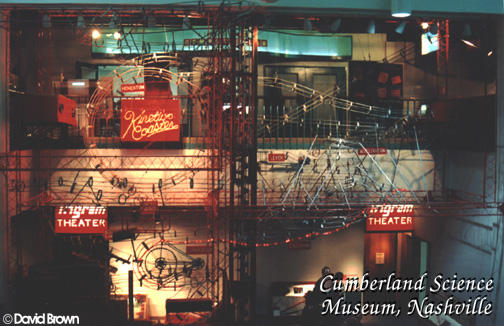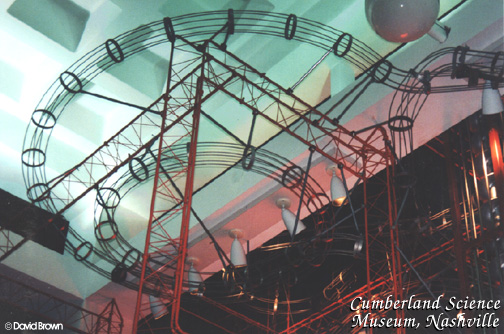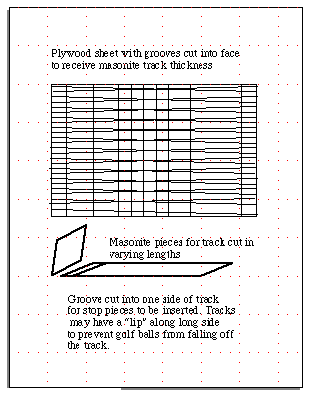
The Rolling Ball Web
An Online Compendium of
Rolling Ball Sculptures, Clocks, Etc.
By David M. MacMillan et. al.
Note: The essay by Mike Petrich is essential reading for anyone interested in the pedagogic aspects of rolling ball devices.
The Science Museum of Minnesota and Karen Thimmesch, a 4th grade teacher at the [Science Museum of Minnesota?] Museum Magnet School, have an ongoing project devoted to Students as Designers. This project covers many types of scientific and engineering discovery and invention, including the creation of rolling ball machines.
Mike Petrich has written an essay on the use of rolling ball devices (marble machines) in this project, with special attention to their pedagogic implications and possibilities. His essay is located at:
http://www.sci.mus.mn.us/sln/invent/mas714/mmt.html
This essay is a major theoretical (and practical) contribution to rolling ball scholarship, and should be read by all who are seriously interested in this field.
David Brown graciously contributed the following two photos of the HCA Kinetic Coaster at the Cumberland Science Museum, Nashville, TN, as well as this extensive description of the Coaster. Thanks!
My observations of the HCA Kinetic Coaster at the Cumberland Science Museum in Nashville, TN:
Various parts of the coaster are labeled with the principle that is being demonstrated in that section. These include:
- Acceleration
- Conservation
- Trajectory
- Lever
- Collision
- Turns
- Reflection
- Potential Energy
- Kinetic Energy,
- Conversion
- Energy Change
- Energy Storage
Around the base of the coaster are small exhibits that demonstrate a particular piece or concept of the coaster in a slightly different way. They also have a photograph of the section of the coaster that they are illustrating. Most of these use wooden track and racquetballs. The coaster is constructed of metal rod (about 1/4" dia) forming a caged track. The balls look like the same material as a bowling ball, but smaller (about 6") and weigh 6-8 pounds. The entire machine about 30' tall x 24' wide x 12' deep. Some interesting features of the coaster:
- The mechanism to raise the balls to the top seems to be several large augers welded to the top of each other. It takes 52 hand-powered turns to get the ball to the top.
- The coaster has at least two mechanical switches in it to determine which set of tracks the ball will take on its journey down.
- The "Conversion" section features a bicycle wheel that's turned by the ball as it passes. This turns on a small electric sign that says "Electricity".
- In the "Energy Change" section, a Xylophone plays an ascending scale as the ball goes up a ramp (into "Energy Storage"), then a descending scale as the ball returns.
Plaque at the base:
The HCA Kinetic Coaster: The vision and generosity of HCA Foundation has made possible the Kinetic Coaster. The largest of its kind in North America, the Kinetic coaster demonstrates in an exciting way 12 principles of physics and re-enforces the educational purpose of the Cumberland Science Museum. The Kinetic Coaster was completed in 1986 and is used up to a million times a year. It was designed by Jim Walther and built by the Cumberland Science Museum exhibit staff. Surrounding the Kinetic Coaster are the Kinetic Connection exhibits. These exciting hands-on components explore the physics principles you can observe in the Kinetic Coaster.
(2 images, approx. 196k total)


Photos Copyright © 1998 by David Brown.
The Integrated Teaching and Learning Laboratory of the University of Colorado at Boulder has a rolling ball sculpture named Pythagorean Fantasy. It is claimed that this sculpture is used by sophomores in Aerospace Engineering, who will measure the speeds of balls and the heights to which ball bounce.
This sculpture is shown on the ITLL website at:
http://itll.colorado.edu/Tour/art.html
Thanks to Mark Olejarczyk for discovering this.
Jim Gage saw a rolling ball device at the Children's Museum of Portsmouth, New Hampshire, and has been kind enough to draw a sketch of it.
Jim says of it that:
It was a 4 foot by 4 foot plywood sheet with straight grooves running in all directions. Tracks had a metal edge and could be inserted into the grooves to build a rolling ball on a wall! They used golf balls and had vertical pieces to stop the balls rolling off the ends of the tracks when they changed directions.
Jim noted later that he thinks that the "stop pieces" were attachable to the large board itself, not to the track.

Portsmouth Children's Museum RB Device
Sketch © 1998 by Jim Gage
The Children's Museum of Portsmouth may be reached online at:
http://www.childrens-museum.org/
At the time of writing, their website mentioned, but did not illustrate:
Roll A Way -- an activity where visitors create a path for a rolling ball out of an everchanging maze.
The Museum of the Rockies, at Montana State University at Bozeman, lists in its exhibits a "Time Room" where a rolling ball sculpture illustrates recurring cycles in geological and biological history.
This reference is online at:
http://terra.oscs.montana.edu/wwwmor/tour.html
It is not clear from the photo online what the rolling ball sculpture looks like (or if indeed the sculpture is in the photo).
Thanks to Mark Olejarczyk for discovering this.
With the exception of any material noted as being in the public domain, the text, images, and encoding of this document are copyright © 1996-1999 by David M. MacMillan and David Brown.
This document is licensed for private, noncommercial, nonprofit viewing by individuals on the World Wide Web. Any other use or copying, including but not limited to republication in printed or electronic media, modification or the creation of derivative works, and any use for profit, is prohibited.
This writing is distributed in the hope that it will be useful, but "as-is," without any warranty of any kind, expressed or implied; without even the implied warranty of merchantability or fitness for a particular purpose.
In no event will the author(s) or editor(s) of this document be liable to you or to any other party for damages, including any general, special, incidental or consequential damages arising out of your use of or inability to use this document or the information contained in it, even if you have been advised of the possibility of such damages.
In no event will the author(s) or editor(s) of this document be liable to you or to any other party for any injury, death, disfigurement, or other personal damage arising out of your use of or inability to use this document or the information contained in it, even if you have been advised of the possibility of such injury, death, disfigurement, or other personal damage.
All trademarks or registered trademarks used in this document are the properties of their respective owners and (with the possible exception of any marks owned by the author(s) or editor(s) of this document) are used here for purposes of identification only. A trademark catalog page lists the marks known to be used on these web pages. Please e-mail web@lemur.com if you believe that the recognition of a trademark has been overlooked.
Version
1.8, 1999/03/21.
Feedback to web@lemur.com
http://www.database.com/~lemur/rb-children.html
Go to the: